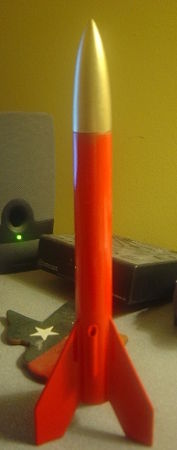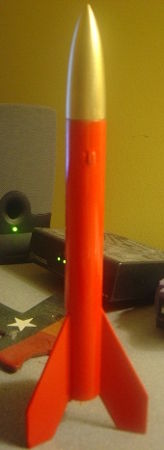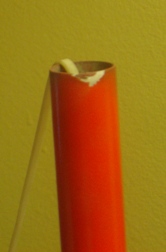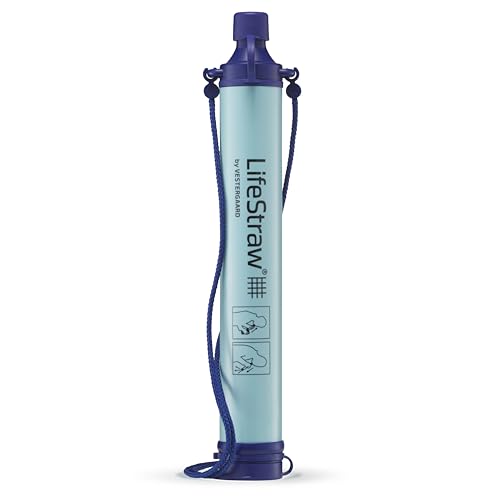| Construction Rating: | starstarstarstarstar |
| Flight Rating: | starstarstarstarstar_border |
| Overall Rating: | starstarstarstarstar_border |
| Manufacturer: | Semroc  |


Brief:
I received this kit from Semroc at NARAM 50. Semroc gave the Mark to anyone who purchased a kit from them. The Mark
is a reproduction of the Estes kit #K-02 and is part of the Semroc XKits line. The XKits line of rockets are
beautifully recreated reproductions of classic Estes, FSI, and Centuri rockets we remember as kids.
The Mark is a simple, super light 3FNC rocket that will really get some altitude on A and B impulse engines, and will fly out-of-sight on C impulse engines. I wouldn't recommend flying this on a C engine as it may become a fly-and-forget-you-ever-had-it rocket.
Construction:
The kit comes with a beautifully turned balsa nosecone, three laser-cut fins, a balsa engine block, a sturdy body
tube, crepe paper streamer, a screw eye, and a rubber shock cord.
- BT-30B Body Tube 6.125" Long
- BNC-30E Balsa Nose Cone
- EB-30 Balsa Engine Block
- FES-K2 Laser-Cut Balsa Fins
- LL-2B Launch Lug
- SC-1A Shock Cord 9"
- SM-1A Streamer 1" x 8"
- TD-1 Tape Disc
Construction directions are not included with the kit. The directions are to be downloaded from JimZ's website. The kit does come with an "instruction manual" that gives a complete history of the rocket. In this "instruction manual", Semroc acknowledges that the streamer is a little short, but is the same length as the original. I have to agree with that assessment and I should also mention that the shock cord is a little too short as well.
Because the instructions were scans of the original Estes instructions, the build was smooth and error free. There were no "gotchas" or alignment issues, and all the parts fit together perfectly.
The only special tool you will need is an empty engine casing to push the engine block to the proper place inside the body tube.
After you have the engine block and fins attached to the body tube, two slits are cut into the top of the body tube just below the nose cone shoulder. The two slits form an opening that will become the shock cord attachment point. This is the first time I have attached a shock cord in this manner. I have to say that this way is very solid, and might outlast a standard tri-fold mount. The down side is the bump that is left on the outside of the body tube.
Once the shock cord is mounted, glue the launch lug on, and it is ready for primer and paint.
One thing I would like to mention, there seems to be two or three scans of instructions for the Mark on JimZ's website. The instructions show two different launch lug mounting points. One set shows the launch lug mounted at a fin root, the other set shows the launch lug mounted between two fins. However, I really don't think it matters where the lug is mounted.
Finishing:
Finishing the Mark is very straightforward. Fill the balsa with the technique of your choice, prime, and paint. I
choose not to use any balsa fillers and just used a high build primer from a spray can found at most automotive parts
or home improvement stores.
After the rocket has been filled, primed, and sanded, paint the rocket the color of your choice. I would recommend a highly visible color as this is a small rocket and can easily be overlooked. Especially in high grass.
I choose to paint mine like the cover picture, which has a red body tube and a gold nose cone. I used the same gold "metal" paint for the nose cone that I used for my Golden Scout. I have not put the black stripes on yet.
Construction Rating: 5 out of 5
Flight:
Both Semroc and the Estes instructions recommend A8-3, B6-6, and C6-5 for engine choices. As I mentioned, I would not
fly this rocket on a C engine as you will most likely never see it again. I would suggest flying this exclusively on A
impulse engines.
The maiden flight was on an A8-3. The flight was straight, fast, and high. I would guess that it went every bit of 600 feet. Ejection was just after apogee. The streamer did not fully deploy though. I am not certain if the streamer got stuck on the shock cord mount or if I put in a little too much cellulose wadding. The rocket came down a little fast but landed in some tall grass and received no damage. Unfortunately, this has been the only flight so far.
There was a small dent on the top edge of the tube. I believe this was from the nose cone snapping back at ejection. Lengthening the shock cord should eliminate this.

Recovery:
The recovery was fine except for the streamer not fully deploying. However, even if it did fully deploy, I still
think it would have come down too fast. I would recommend lengthening the streamer to get slower decent rates.
Flight Rating: 4 out of 5
Summary:
Main PROs: Easy to build. Fast, high flights on low impulse engines. A great rocket for beginners and school
projects. A perfect rocket for small fields.
Main CONs: Short shock cord, short streamer.
Overall Rating: 4 out of 5
Other Reviews
- Semroc Mark By Chan Stevens (October 13, 2008)
Brief: Not being much of a rocketry historian, I was a bit confused when I heard that Semroc was releasing the Mark. After all, I already had stashed away a numbered Mark II kit, as well as a Mark II offered in 2007 at NARCON. Looking over the JimZ archives , I could see very little difference between the Estes Mark and the Estes Mark II. After a bit of research, I learned ...
 |
 |
Flights
Sponsored Ads
 |
 |









